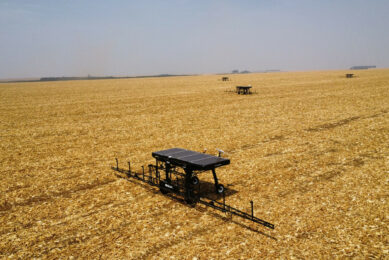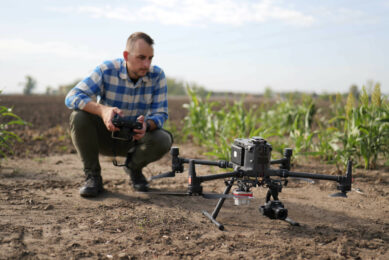FAA approves new eVTOL technology Guardian Agriculture SC1

Guardian Agriculture’s SC1 aircraft may appear to be just another large agricultural drone, but it’s not. It is the first eVTOL of its kind to have (just recently) received approval for nation-wide operation from the U.S. Federal Aviation Administration (FAA).
The use of drones for crop scouting, application of fertilizer and crop protection products and seeding is nothing new at this point. Tens of thousands of ag drones are already in use in China and many other countries. The Guardian Agriculture’s SC1 may appear just another drone, but it’s not. Due to its size, aerospace-grade components and AI system, it’s classified as an electric Vertical Take-Off and Landing (eVTOL) aircraft, and the first eVTOL of its kind to have (just recently) received approval for nation-wide operation from the U.S. Federal Aviation Administration (FAA). Specifically, the FAA has approved line-of-sight operation for up to 30.48 m of elevation and maximum speed of 29 miles/hr.
On US farms this summer
The SC1 is specialized for automated spraying and/or seeding, operated with pre-programmed flying patterns that align with GPS field maps. It can carry up to 200 pounds of tank and tank contents and covers about 40 acres per hour (including charging and tank filling). It will roll out on farms in the US this summer.
“Using the SC1 is less costly than aerial spraying, and aerial spraying service can be tough to book in many states as the demand is so high and there can be limitations from weather conditions,” explains Guardian’s CEO Adam Bercu. “Our main customers are custom spraying firms. Our systems will allow them to service customers much more efficiently and at a lower cost. However, we envision that every farmer with a large acreage can and should have our systems. At $ 300,000 USD, it’s competitive with a new sprayer, and our operating costs are much lower as well. And of course, the SC1 can operate 24 hours a day.”
Text continues below picture

Confident in technology
Guardian’s first customer is Wilbur-Ellis, which provides both crop protection products as well as spraying, data and consulting services to farmers throughout the western two-thirds of the US. It is the largest custom spraying firm in the country. Vice President of Supplier Relations Willie Negroni has stated in a news release that “we are so confident in the technology and the Guardian team that we are not only a customer, but also an investor.” Wilbur-Ellis has an option to buy 400 Guardian SC1s.
Total Guardian pre-orders total $ 100 million USD at this point. “We’re manufacturing as fast we can,” says Bercu, “and about to start building a factory. It’s very important to us that our manufacturing is in the US and the vast majority of our components are made in the US or Europe.”
How it works
Using the SC1 involves the same system that supports the use of spray booms on a farm: a tank truck with the product for spraying is brought close to the targeted fields. But instead of filling the spray boom tank periodically, the farmer or custom sprayer refills the SC1 tanks. That is, when the SC1 comes back with an empty tank, it can be quickly refilled using the same methods as farmers use for other systems. There will need to be a diesel generator on the truck or a power source, for charging the SC1 battery.
That is, because the SC1 battery weighs about 100 pounds, it’s not really feasible to swap in a fresh one for a drained one. The battery was therefore designed for super-fast charging, which needs to happen every three or four spray runs (the SC1 tank is emptied in about 3 minutes of spraying, and total flight time per charge is 12-17 minutes).
We are also very excited about the ability to spray biological products very close to the growing crop
The spraying itself, like the battery, was also carefully designed. “We built our spraying operation backwards, from looking at the limits of how products must be sprayed according to label directions relating to the amount of wind that can be present,” says Bercu. “This means that we ensured the ‘downwash velocity’ from the propellers is low. We are also very excited about the ability to spray biological products very close to the growing crop, which is a requirement for most of these products and not possible with aerial spraying. We think our technology is really going to open up the use of biological products. Our aircraft is GPS-enabled but also equipped with RTK if you want it get accuracy to the centimeter level.”
Text continues below picture

Main input formats
Pre-programming of flight plans is very straightforward. The Guardian system can accept all the main input formats from existing GPS farm maps. Custom spray companies already have these from their customers.
Besides application of insecticide, fungicides and herbicides, Guardian is working to enable the SC1 to do aerial broadcast seeding, the type that’s done with airplanes,. “Cover cropping is something we’re particularly excited about,” says Bercu, “because this technology makes it easy to apply in the late season without causing crop damage. ”
In addition, the Guardian team is working on receiving permission from the FAA to go beyond line-of-sight operation and fully-automatous operation (with no need for supervision). After expansion in the US market, Guardian is targeting Canada, Mexico and Brazil next. They also plan to construct larger type-certified eVTOL models.
Join 17,000+ subscribers
Subscribe to our newsletter to stay updated about all the need-to-know content in the agricultural sector, two times a week.



